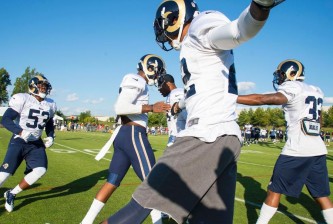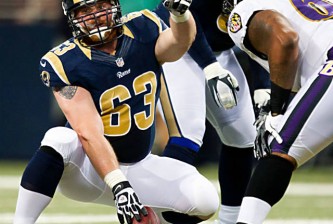This game hardly needs introduction: it is as revered in Rams history as any single moment or achievement of the franchise’s history. This game crowned the miraculous worst-to-first rise of the team colored royal blue and corn yellow, befitting its mix of world-class talent (Marshall Faulk, Isaac Bruce, Torry Holt, Orlando Pace) and products of more humble origins (Kurt Warner, London Fletcher, most of the offensive line).
Very few of the players on this tape are still playing today. Some, like Faulk, are long retired and already eligible for Hall of Fame induction, and others will follow soon. Others have fallen out of the game and have been all but forgotten. And one, the tragic case of Steve McNair, is no longer on this earth.
This time capsule also contains a good share of melancholy as we consider the dynasty that could have been, perhaps should have been, contained in the core of this team, but was frittered away by equal parts ego and incompetence.
Origins of the team:

Dick Vermeil was a protege of Sid Gilman’s vertical passing offense — the offensive system that influenced Don Coryell, Al Davis and Bill Walsh alike. When he arrived in St Louis, though, he didn’t have anything close to the right fit of coaching and talent, inheriting Tony Banks and drafting Lawrence Phillips, and trying to lead them with a cadre of old men that included assistant coach Mike White, offensive coordinator Jerry Rhome, and offensive line coach Jim Hanifan. The hope was to bring an old-school toughness back to St Louis; the result was an old-school disaster.
After two years of failure, Vermeil was urged to start over, and he did by reaching back into the Redskins (where Rhome was plucked from) for a student of Norv Turner’s branch of the Gilman offense: a little-known quarterbacks coach named Mike Martz.
A lot of little things that had gone so awfully wrong started to go right. Waiting for Martz was a third-string quarterback who barely made the roster over Will Furrer in 1998.
So little did Martz know of Warner that when the quarterback went to Martz’s office to introduce himself, Martz first thought Warner was a tight end.
The Rams spent the offseason aggressively assembling talent: QB Trent Green was signed, RB Marshall Faulk was dealt for, WR Torry Holt was drafted. And Martz began drawing up a phone book of plays designed to stretch the mostly zone-based defenses of the time beyond their breaking points. The result — though it was Warner and not Green who led it — was known as the Greatest Show on Turf.

The Opponent:
Jeff Fisher’s Titans had been emerging as a force in the AFC South, behind the steady Steve McNair and powerful rock of a running back, Eddie George, but the heart of the Titans’ dominance lay in their ferocious defense, which had been taken to the next level by a “freak” defensive end, Florida’s Jevon Kearse.
The Titans, like the Rams, were recent arrivals in their new digs; after two seasons spent playing in west Tennessee, ’99 was the first year spent in their shiny new stadium in Nashville, and their home field advantage was every bit as raucous and imposing as that of the domed Rams. The crowd in Atlanta’s Georgia Dome leaned strongly toward their brethren of the South.
This Super Bowl appearance stands as the only one of the franchise’s history, and they came one yard short of perhaps turning it into a championship trophy.
For Mike Jones and the Rams, that one yard makes all the difference in the world.






















